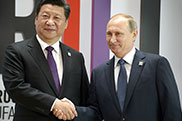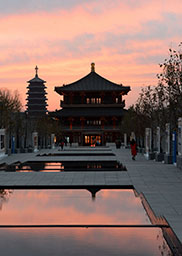 Thinkstock
Thinkstock
Article
Asia’s largest nation has battled air pollution for years. Yet smog is not the only problem. Other social, economic and military concerns make the coming years look uncertain.
Learn the why behind the headlines.
Subscribe to the Real Truth for FREE news and analysis.
Subscribe NowRoughly 4,400 die each day from air pollution in China. That comes to 1.6 million deaths per year and roughly 17 percent of all deaths in the nation, Berkeley Earth, a California-based climate research organization, reported.
Smog-choked skylines are the ugly side of breakneck progress for the Asian nation. For years, it has enjoyed seemingly unstoppable growth: A GDP of over $10 trillion, rising global ambitions and clout, and the biggest middle class in the world.
A nation of farmers only 50 years ago, it has risen to become the world’s second largest economy and home to some of the world’s largest, most advanced cities.
Yet rapid development has caused immense problems: half of China’s rivers and lakes are severely polluted from industrial and chemical waste. Each year, 800,000 citizens develop lung cancer, primarily from air pollution. Deaths from the disease surged nearly 465 percent over the last three decades.
These negative effects have spurred the Chinese government into action. For the past three years, it has worked to mitigate the effects of pollution—namely forcing the closure of small industrial companies.
Reuters explained the results of the campaign: “On the outskirts of Beijing, the disused factories of Chaomidian show the impact of China’s drive to shut down thousands of small firms causing big pollution. Amid scrapheaps and idle machinery, the community has clean air these days—and no jobs.
“After a three-year campaign, China’s push to cut smog appears to be paying off, whatever the localized cost, just as economic growth weakens to its slowest pace in 25 years. Chinese cities saw an average 10 percent drop in key pollutants [in 2015], according to Greenpeace.”
While China did reduce smog, it destroyed many jobs. In addition, Beijing issued its first air quality “red alert” in December last year after heavy pollution reduced visibility to less than a mile. The government warned citizens to avoid all outdoor exertion, closed schools and construction sites, and ordered some industrial plants to cease operation.
Coal is the major reason for such widespread air pollution. China produces and consumes nearly as much coal as the rest of the world combined.
 ChinaFotoPress via Getty Images
ChinaFotoPress via Getty ImagesThe nation has pledged to cut back. During the international environmental summit in Paris last year, China promised to modernize its coal power plants by 2020 and cut emissions by 60 percent.
Yet this means more factory closures are coming, and more jobs lost.
Pollution is just one negative effect stemming from China’s mammoth growth spurt. In a nation of 1.4 billion, everything is blown up to a massive scale. Invariably, the solutions to problems lead to even more complications.
A spike in population, spiraling national debt, and widespread infrastructure shortages all cast a pall of uncertainty over the emerging superpower. Yet all of this has not interrupted amazing growth.
To onlookers and citizens alike, the Asian nation’s future remains hazy.
Economic Transformation
China’s national development has led to a massive relocation of the population from the countryside to cities. About 300 million have moved already, with another 300 million expected to do so by 2030.
Put in perspective, this is like the entirety of the United States relocating twice.
To hurry the transition, Beijing plans to urbanize 100 million rural citizens within the next five years through a process called “townification.” Instead of moving them into cities, construction crews will develop urban sprawl around small towns and tribal communities. This process, according to Forbes, will “require the construction of 50 Bostons, or six Shanghais, by 2020.”
All of this is part of the communist government’s goal to establish a consumer nation. President Xi Jinping is working to create a more substantial middle class, which will increase internal spending. By encouraging the migration of workers from rural jobs to urban ones, a rising middle class, he believes, will increase the demand for goods and services.
So far, an increasing urban population, with greater access to jobs and amenities that cities have to offer, has helped with GDP growth. Individual standard of living has also increased, with GDP per capita quadrupling to nearly $12,000 between 2000 and 2013.
The nation’s middle class is already larger than that of the United States, with 109 million Chinese citizens earning between $50,000 and $500,000.
 Kevin Frayer/Getty Images
Kevin Frayer/Getty ImagesYet for China to keep rising, it needs to sustain this economic growth—a seemingly impossible task.
Bloomberg wrote: “China’s urbanization policies were designed to bring hundreds of millions of people from farms to the cities over the next decade in an effort to unleash a surge of consumption greater than any the world has seen. The coming urbanization boom has been heralded by analysts, academics, and even by China’s top leaders. ‘China has much room for urban, suburban, and regional development and domestic demand has huge potential,’ said Chinese Premier Li Keqiang on Jan. 21 at the World Economic Forum in Davos, Switzerland. ‘Domestic demand will keep improving and bring even greater development for the world.’”
The problem? Domestic consumption shrank from 8.5 percent in 2009 to 7.1 percent today, Bloomberg reported.
Urban jobs are starting to dry up too. According to Business Insider: “For years it seemed that there were plenty of jobs to go around for everyone looking for one in China.
“The pace of rural workers moving to cities to find work and older people leaving the labor force was keeping the market tight. Then, as GDP growth slowed, the people seemed to evaporate.
“Chinese authorities knew this would happen eventually, that after pouring into jobs in cities the migrant worker deluge would have to end.
“It’s just that it happened before anyone thought it would, before the purchasing power of those with jobs was strong enough to support the domestic development of jobs for those without them, especially people in the country and those too old to work.”
Urban relocation has also led to significant social woes, including chronic unemployment, lack of healthcare and education, the expansion of slums, and thousands of protests each year by disgruntled farmers.
The Economist summarized: “Residents are beginning to question whether their quality of life, which for many has improved by leaps and bounds, will continue to do so. The giant cities are polluted, pricey and congested. Average travel speed in Beijing is half that in New York or Singapore.”
 Greg Baker/AFP/Getty Images
Greg Baker/AFP/Getty ImagesAs rural residents are forced to move to urban centers, many are not finding work opportunities.
“Farmers are often unwilling to leave the land because of the lack of job opportunities in the new towns,” The New York Times reported. “Working in a factory is sometimes an option, but most jobs are far from the newly built towns. And even if farmers do get jobs in factories, most lose them when they hit age 45 or 50, since employers generally want younger, nimbler workers.”
Amid these growing problems, the only way Beijing can continue its economic advancement is by continuing to spend money.
Government Support
Sustained GDP growth has a hefty price tag. The government’s borrowing has quadrupled over the last seven years. This equals $28 trillion in public and private debt—larger than that of the United States or Germany. In addition, the debt rate is increasing while GDP growth has been slowing since 2011.
Business Insider reported: “In 2005, China’s debt was 164% of GDP. Now it’s 236% of GDP. It’s not the scale that’s worrying. Many countries have debt that is twice GDP. It’s the speed at which it is changing, compared to the slower pace of economic growth.”
To make matters worse, the government currently has a $174 billion yearly budget deficit.
Much of China’s cash goes into the construction of its infamous “ghost cities”—vacant communities filled with high-rises, shopping malls, and even theme parks. These pump up GDP growth because they count as real estate development. They have also created jobs through which the government could pump funds into the economy.
 Alexander Nemenov/AFP/Getty Images
Alexander Nemenov/AFP/Getty ImagesYet these cities have taken away materials and funds from real population centers, and experts believe they will remain uninhabited for decades.
Forbes reported that the building projects were “evidence that China’s growth of the last 20 years was based on building things nobody needed or wanted. This was planned obsolescence on a grand scale. And now that the economy is slowing, what will become of those cities? Many of them are debt burdens carried by the developers who haven’t sold a single unit.
“From shopping malls to soccer stadiums, hundreds of new cities in China are largely empty. And yet more cities are still being built deep in the heart of the country. All in hopes that its rural population will one day move to a flat in a city without a mayor.”
Despite these empty, half-built metropolises, Forbes reported that the country is now drawing up plans to construct new settlements for as many as 3.4 billion people—two billion more than the nation’s current population!
Even when a newly built city does attract citizens, there are still severe downsides. Another Forbes article stated: “Urbanization Chinese-style…forces agricultural populations from their land and into nearby highrises, where they are employed as maintenance workers or simply given extra units to rent out for income—should they be able to find renters. Urbanization thus destroys jobs rather than creating new employment.”
Taking people from farms and mines has forced the government to look elsewhere for natural resources and food.
In Africa, China has made $26 billion of investments in raw materials, mining and energy. It also offered an initial payout of $10 billion in loans to African nations, promising up to $1 trillion in financing by 2025.
Across the Pacific, China is seeking oil and food from Canada. Han Jun, vice minister of financial and economic affairs, told The Globe and Mail: “What is China most in need of? We have a shortage of agricultural products. China is the biggest importer of agricultural products in the world and, also, we are one of the countries with the highest dependency on imported energy from other countries.”
Mr. Han proposed a free-trade agreement with Canada to promote an easier and cheaper transfer of goods between the nations.
President Xi visited the United Kingdom last October and struck over $43 billion of trade and investment deals. This included a $26 billion investment in Britain’s nuclear power plants, which would allow the Asian nation to receive a portion of shares from the plant’s stocks.
More Spending
Government spending does not stop there. Other items on the Chinese budget contribute to a massive cash outlay—all in an effort to one day be a global superpower.
Military expansion: The nation is seeking to assert more dominance near and abroad. Early in 2015, the government announced a 12.2 percent increase in military spending over last year to $132 billion. It has the second highest defense budget in the world, which is expected to increase to provide for an expanding naval fleet and projects such as airstrips built on manmade coral reef islands.
The actual defense budget may be even higher when factoring in “off the book” costs. An April 2015 report from Stockholm International Peace Research Institute stated that China’s real military spending is probably closer to $216 billion.
Space exploration: The nation, following the pattern of the United States, has planned to send probes to the “dark side” of the moon. To date, a spacecraft has never landed on the moon’s far side. Afterward, China plans on sending a manned mission there to conduct research and solidify the nation’s place in the 21st-century space race. This all comes with a price tag of about $2 billion per year.
Stock markets: China is pumping funds into the plummeting stock market to prop it up—an unsustainable move according to most economists. Over the summer, Beijing provided $236 billion to buy out stocks. It also banned large stockholders from selling their stocks.
For the Chinese government, all of these actions are an attempt to secure its nation a starring role on the world stage. The question is whether the high-risk, high-cost policies will pay off—or cause the emerging superpower to eventually crash and burn.
Some economists consider China’s current economic problems short-term growing pains. They point to America’s transition from an industrial economy to a middle-class consumer economy after the Great Depression as an example of why the Asian nation should continue moving forward.
Other economists, however, believe this comparison does not work and point out that the United States had a lot less people in the 1940s, much more time, and more wealth.
 Goh Chai Hin/AFP/Getty Images
Goh Chai Hin/AFP/Getty ImagesChina’s transition to a consumer nation will involve “redirecting hundreds of millions of people and trillions of dollars of capital,” a Reuters opinion piece reported. “Nothing like it has ever been attempted.”
Long-held Pattern
Backing China’s sky-high aspirations is its millennia-long history of awesome achievements and ability to weather hardships.
An obvious example of this is the Great Wall of China, one of the largest construction projects ever. Built over 2,000 years, it consists of 5,500 miles of walls and natural barriers, some running parallel to each other. Consider that this is roughly equal to the entire coastline of the continental United States!
The Great Wall required the work of hundreds of thousands of conscripted soldiers and citizens at any given time. While built primarily for defense, it is also a symbol of Chinese imperialism, engineering genius, and manpower superiority. Centuries ago, the barrier even allowed control of trade and travel along the Silk Road.
Yet this all came at great cost. During the Qin Dynasty (221-206 BC), experts estimate that up to one million workers died building the wall.
The Chinese people have also endured many of the greatest natural disasters of all time.
- Six of the world’s top 10 deadliest floods and landslides—including the top five—occurred in China. The deadliest, the 1931 China floods, killed between two and four million. Following this were the 1887 Yellow River flood, which claimed one to two million lives, and the 1938 Yellow River flood, which resulted in 500,000 to 700,000 deaths.
- China had the top three of the world’s top 10 most fatal earthquakes. Considered the deadliest of all time, the 1556 Shaanxi quake reportedly killed over 830,000 people. The 1976 Tangshan earthquake killed between 240,000 and 780,000.
- China had six of the world’s top 10 deadliest famines, including the top two. The Great Chinese Famine between 1958 and 1961 claimed between 20 and 43 million lives—the deadliest ever recorded.
In addition to natural disasters, the nation has been involved in some of the greatest wars throughout its history.
The Mongol invasion of China spanned six decades in the 13th century. It was estimated to kill over 10 million citizens and result in heavy military losses.
During the Second Sino-Japanese War, which was fought before and during World War II, anywhere between 10 to 25 million Chinese civilians and over three million military personnel died from war-related violence, famine and disease.
Two characteristics helped the Chinese through all of these hardships: enduring resilience and impressive numbers.
The book The Chinese People at War by historian Diana Lary detailed China’s national character: “The transcendence of trauma has been an almost commonplace feature of modern Chinese history. The endurance and toughness with which millions of people have endured terrible hardships and still kept going, with dogged determination, is something that fills foreign observers with admiration.”
Yet understanding Asia’s ancient roots reveals even more about China—and paves the way to understand its future.
Unknown to almost all, the Chinese and its neighbors have a common ancestor described in the Bible: Japheth, one of Noah’s sons.
Japheth gave rise to the likes of China, Russia, India, Mongolia, Korea, Japan and other Asian nations. Note what was foretold about this Bible figure in the book of Genesis: “God shall enlarge Japheth…” (9:27).
No other family of races comes close to the sheer size of Asian nations. Well over half of the global population comes from that region.
The fact that God said He would enlarge Japheth and then did it is one small proof of the Bible’s validity. Numerous other fulfilled prophecies confirm that this Book is divinely inspired. For more irrefutable evidence, read Bible Authority...Can It Be Proven?
God’s Word reveals much more about China’s future. While the nation will continue to have difficulties for a short time, it is destined for a period of unprecedented prosperity. Also, it is foretold to later align with Russia and other Asian nations as part of what the Bible calls the “kings of the east” (Rev. 16:12).
Keep reading The Real Truth, which will continue to explain prophecy and how it relates to world events. Do not let the coming years be hazy or uncertain!
More on Related Topics:
- Two Years On, Survivors of Turkish Earthquake Still Struggle with Loss and Hardship
- What to Expect After South Korea’s Impeached President Was Indicted on Rebellion Charges
- The Discovery of Brutal Mass Graves in Syria Reveals a Legacy of Horror
- China’s Population Falls for a Third Straight Year, Posing Challenges for its Government and Economy
- What to Know About South Korean Acting President Han’s Impeachment



